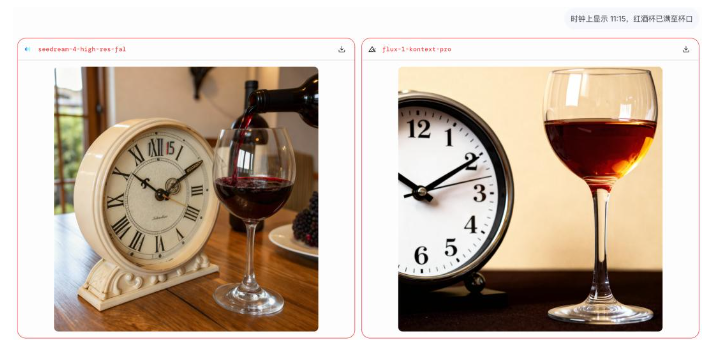While other AI models are still struggling with questions like "does the clock hand point to 11:15?" or "is the red wine really full to the brim?", Nano Banana2 has quietly achieved a precise leap in image generation. This newly upgraded AI image model not only solves long-standing industry challenges in complex detail restoration, but also brings AI drawing from "random generation" into a new era of "controlled refinement" by simulating the multi-stage creative process of human designers.
The Victory of Detail Enthusiasts: Text, Time, and Light No Longer "Crash"
The most impressive breakthrough of Nano Banana2 lies in its faithful execution of high-precision semantic instructions. When faced with prompts containing multiple precise elements, such as "the clock shows 11:15, and the wine glass is full to the brim," the model can correctly draw the clock face, the angle of the hands, and realistically present the surface tension of the liquid and the refraction through the glass—something that mainstream models like GPT-Image and Gemini 2.0 often fail at, resulting in errors such as misaligned hands, deformed glasses, or distorted liquid surfaces. Moreover, it can generate unconventional creative concepts like a "glass burger," accurately integrating materials, structure, and lighting, showcasing a world knowledge understanding far beyond its peers.

Say Goodbye to "One-click Generation": A Five-step Workflow Simulates Designer Thinking
Differing from traditional AI's "input-to-output" black-box model, Nano Banana2 introduces a five-step workflow: planning → generation → review → correction → iteration. For the first time, this structure makes the AI image generation process systematic and modifiable. Users can adjust the perspective, rewrite text elements, or optimize composition logic during intermediate steps, while the system dynamically optimizes subsequent steps based on feedback. This "human-computer collaboration" mechanism greatly enhances the controllability of complex tasks, such as precisely controlling architectural perspective, product label text layout, or character gesture details.
Still Some Minor Flaws, But the Direction Is Clear
Although there are occasional typos when generating posters with a lot of text, the overall accuracy has far exceeded industry standards. Developers admit that this is a normal challenge during AI's transition from "generalization ability" to "professional-level output." In the future, they will continue to optimize through more fine-grained text-image alignment training.
AIbase believes that the significance of Nano Banana2 goes beyond technical improvements; it redefines the quality standards for AI image generation. When users no longer need to "try ten times and pick one," but instead achieve their expectations "on the first attempt," the productivity boundaries of creative workers will be completely opened up. This image revolution driven by details may be the starting point of AI truly integrating into professional design processes.
